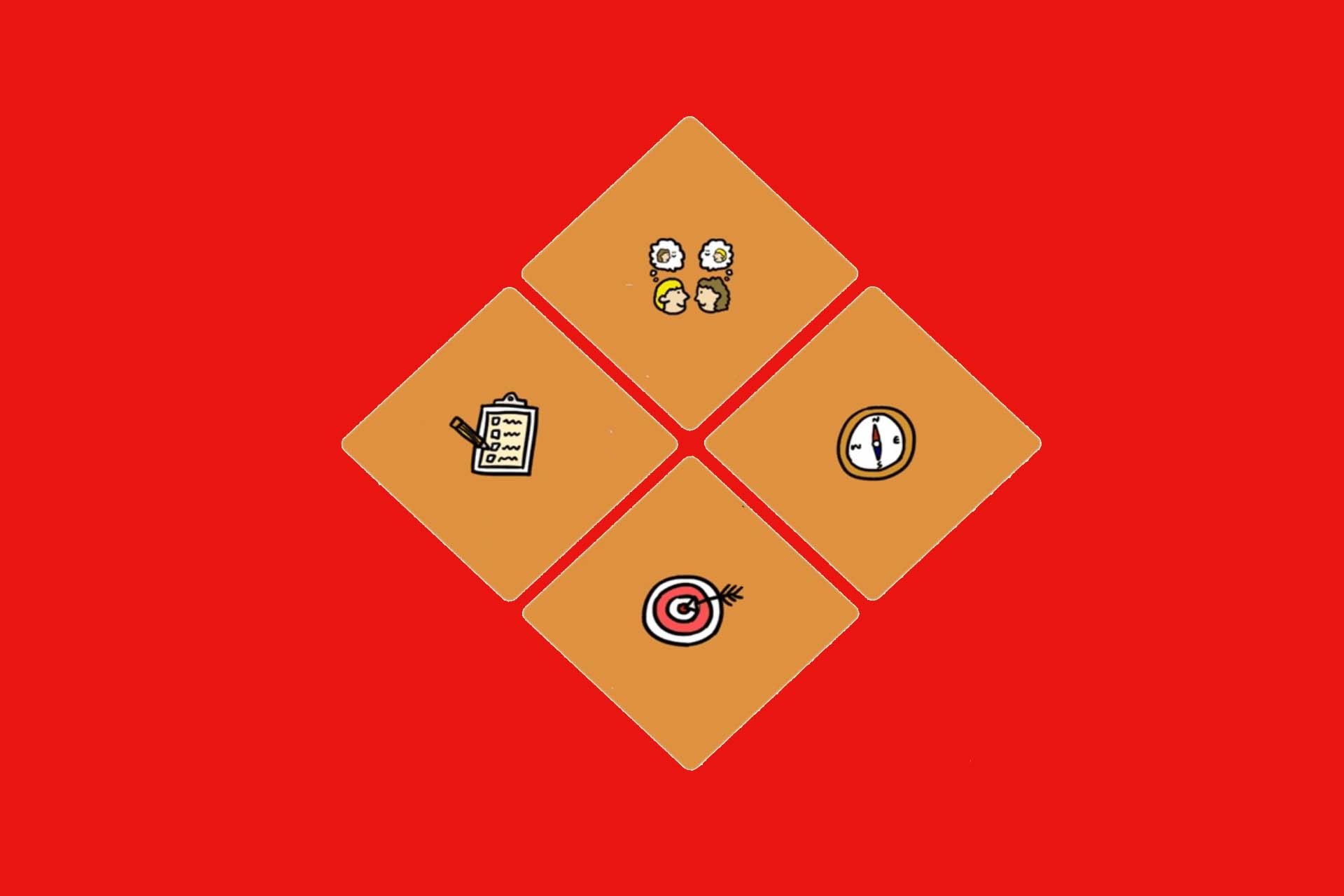How does the True Leader bring the Agile Mindset into the team?
Wow, there are two bold terms in the headline. For some, it’s the entry into agile bullshit bingo, for others it’s the prerequisite for their good work.
Let’s start with mindset: does it even exist, why do we need it, why should we change it, and how can we do it?
Why do we actually need a mindset?
Let’s take a little trip back in time. For millions of years, we have been in the threefold struggle of evolution:
- reproduction,
- survival and
- adaptation.
For this we had to and still have to make big and small decisions again and again. If possible, quickly, at least faster than others, to stay ahead.
If you read this, one thing is clear – your ancestors and now also you have managed this well, at least up to here, and gained vital experience in the process. Hopefully, these will also support you in making sensible decisions in the future. Here we already come to a tricky point because these decisions must be meaningful only for you personally. Others can see it quite differently. You have certainly experienced this, actively or passively. But more about that later.
To react quickly we must decide quickly – or we can fall back on prepared, experience-based decision patterns. If ,,,, then! That is why we have stored certain presets. These presets contain how we perceive certain situations, how we feel about them and how we act in a meaningful way in these situations. Mindsets, settings of our mind, action-oriented basic settings are nothing else. And we have a lot of them, for different social and life areas.
Me and the road traffic regulations – an example from everyday life
Let’s take road traffic as an example from everyday life. There are people who scrupulously adhere to the speed limits, their mindset: “I follow the rules”. Others don’t care what it says, they drive as they feel like it and notoriously live out their mindset “I’ll drive as fast as I want to”. And a group in between always has the speedometer needle exactly 10 miles/h above the permitted speed, mindset: “Plus 10 fits”.
All three types automatically implement, without much thought, the course of action they have entered in their “Manual of Quick Decisions”. It seems to make sense to them, at least more sense than other behavior patterns.
They will only change their behavior if it no longer makes sense. If they might miss the plane because of a traffic jam; if their partner doesn’t get into the car anymore because of their driving style; because the fine turned out to be more blatant than expected; if they had a serious accident or witnessed it; because the fine catalog was changed…
The bottom line is that they change their behavior rule because experiences or changed conditions have changed their own view and a different behavior now seems more sensible.
What do you think about other opinions?
Let’s take another topic, dealing with disagreements. This is the crux of everything you want to do together with other people. The breaking point of life. What have we written for dealing with clashing opinions in our “Manual of Quick Decisions”, what is our mindset here?
In the old, hierarchical and power-driven world, for those in power, it’s “I know how to do it and I implement or enforce what I need”. That makes sense; that’s how you get ahead in this world. Most of us have been socialised in this world, have been taught exactly these behavioral patterns over and over again. Now we apply the behavioral and linguistic patterns that match them, thus reproducing the old world as long as we don’t think about it.
However, the world of work has changed. Cooperation at eye level, equality in the team, personal responsibility and much more have become important. A suitable mindset might be ‘Together we always seek and find the best solution for everyone involved”. Disagreement is no longer an obstacle here, but an important driver, “Being right” is overwritten with “Finding a good solution”. It is less about assertiveness than about facilitation skills, being able to listen is more important than making announcements, thinking in new ways is more helpful than following the old tracks.
Resistance in change processes
A different behavior has become more meaningful, so everyone spontaneously changes their behavior, changes their mindset for the agile world. It would be nice. But why don’t they?
Simply because many components play into “meaningful behavior”, because almost all change involves gains and losses, and the outcome looks different for everyone.
Let’s talk about loss scenarios. What might we fear in the shift from instruction-triggered to self-directed work? For example:
- I have to decide? What if I’m wrong…
- What about the position I’ve built up over many years…
- My work is becoming more transparent, it could be tight…
- I’m glad when I can work in peace, all these votes are getting me down…
- My performance – my recognition! Dragging the others along? Not my thing…
- …
It’s about safety, competencies, reputation, career paths, loss of face, status and much more.
What looks like “resistance to change” from the outside is nothing more than the individual fight for personal safety and security. Which brings us back to the threefold struggle of evolution. You can’t talk anyone out of his needs.
This looks bad for the work on the agile mindset. But we still have the “True Leader” to fix it.
True Leader – Servant Leader – Gardener: Which now?
I like the image of the gardener to describe the new leadership role, which is to support people in organizing their work as a team step by step independently and on their own responsibility. The gardener knows a few things so that everything develops optimally:
- The location with all its conditions is crucial.
- Everything has its time and its measure. (Grass doesn’t grow faster if you pull on it, but it could tear. Too much watering and too much fertilizer is just as harmful as too little.)
- The tots need to be protected.
I also like the image of the gardener, because talking into the plants doesn’t help much, but looking closely does. (The dialogue with the plants as meditation is rather a good way to become aware of problems and to play through variants in one’s head.)
The Servant Leader not as a servant but as a service provider of his team corresponds for me exactly to this image of the gardener who observes with calmness and distance how the team develops and acts with prudence. He helps the team with the right questions at the right time to find the blind spots in self-reflection, to decide on the next steps, and to improve their interaction with each other.
He can also stimulate the discussion whether this “Together we always look for and find the best solution for everyone” can become a pattern for the new behavior, the new entry in the “Manual of Quick Decisions”. And he can support the discussion, what this description means for the behavior of each individual, especially in dealing with different ideas and opinions.
And the team can measure its own behavior against this phrase again and again, without a canon of values of abstract terms that everyone interprets in their own way. And with each further stage of development according to Tuckman and Lencioni, the team can penetrate deeper into the secrets of good teamwork.
Renaming the Servant Leader to True Leader now – can be done. Words guide our thoughts and actions. “Servant Leader” contained a clear message with action guidance – you are a service provider to your team and ensure their optimal development. “True Leader” is open to interpretation and requires far more explanation. So, what is gained by this?
Conclusion
“Agile Mindset” is used to describe the behaviors that enable you to work well together in the agile world. Some already have it, some are working on it, others are still hesitant to take the step because for them the disadvantages outweigh the benefits, or they have not yet experienced any personally relevant advantages.
The Agile Mindset cannot, to speak with Klaus Leopold¹, be implanted or massaged in, and it certainly cannot be prescribed or demanded. But intensive discussions can lead to re-evaluating frameworks and behavior patterns for oneself. Smart questions from the Servant Leader, discussions close to practical events, and conversations with already-practicing Agilists about the peaks and valleys of their journey help.
Notes:
[1] Klaus Leopold: Agilität neu denken
Conrad Giller has published a series of posts here on the blog under the title Survival Training for Agile Samurai. It is the motto of his Agile Night School. There he offers workshops and trainings on communication and social skills for leading and developing teams, as well as working in the New World.
Conrad Giller has published more posts in the t2informatik Blog, including

Conrad Giller
Conrad Giller has been working for about 30 years as a trainer, coach and consultant for almost all challenges of oral communication: conflict, team, leadership, storytelling, presenting, moderating, media, etc. He is happy to pass on his experience online and offline in workshops.



